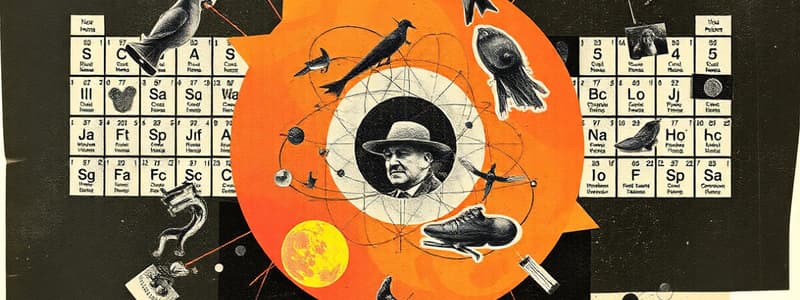Podcast
Questions and Answers
What is the charge of a proton?
What is the charge of a proton?
- Variable
- Negative
- Neutral
- Positive (correct)
An atom with a charge other than neutral is called a proton.
An atom with a charge other than neutral is called a proton.
False (B)
What is the simplest form of matter?
What is the simplest form of matter?
Element
The formula for water is __________.
The formula for water is __________.
Match the following terms with their definitions:
Match the following terms with their definitions:
What does the atomic number indicate?
What does the atomic number indicate?
Covalent bonds are formed when atoms share electrons.
Covalent bonds are formed when atoms share electrons.
What happens to the number of protons when an atom changes into a different element?
What happens to the number of protons when an atom changes into a different element?
Flashcards
Element
Element
The simplest form of matter, cannot be broken down further.
Periodic Table
Periodic Table
Table organizing all known elements.
Atom
Atom
Smallest unit of an element.
Proton
Proton
Signup and view all the flashcards
Neutron
Neutron
Signup and view all the flashcards
Electron
Electron
Signup and view all the flashcards
Atomic Number
Atomic Number
Signup and view all the flashcards
Atomic Mass
Atomic Mass
Signup and view all the flashcards
Ion
Ion
Signup and view all the flashcards
Isotope
Isotope
Signup and view all the flashcards
Compound
Compound
Signup and view all the flashcards
Ionic Bond
Ionic Bond
Signup and view all the flashcards
Covalent Bond
Covalent Bond
Signup and view all the flashcards
Molecule
Molecule
Signup and view all the flashcards
pH Scale
pH Scale
Signup and view all the flashcards
Study Notes
Basic Chemistry
- Elements are the simplest form of matter, indivisible into simpler substances.
- The periodic table contains 120 known elements, each with a unique symbol (e.g., Au for gold).
- Atoms are the building blocks of elements.
- Atoms consist of:
- Protons: Positively charged, located in the nucleus.
- Neutrons: Neutral, located in the nucleus, similar size to protons.
- Electrons: Negatively charged, orbit the nucleus, much smaller than protons or neutrons.
- Atomic number: The number above the element symbol, representing the number of protons (and in a neutral atom, electrons).
- Atomic mass: The number below the element symbol, representing the total number of protons and neutrons.
- To find the number of neutrons, subtract the atomic number from the atomic mass.
- Ions form when the number of electrons changes, altering the charge of the atom.
- Changing the number of protons changes the element.
- Isotopes form when the number of neutrons changes; they are generally unstable and radioactive.
- Compounds result from two or more elements bonded together.
- Ionic bonds occur when one atom donates an electron to another.
- Covalent bonds occur when atoms share electrons.
- Molecules are the smallest functional units of compounds. For example, H₂O is a single water molecule.
- The pH scale measures the concentration of free hydrogen ions in a solution.
- A pH of 7 is neutral.
- A pH of less than 7 is acidic.
- A pH of greater than 7 is alkaline (basic).
- A change of one whole number on the pH scale represents a ten-fold change in hydrogen ion concentration. A pH of 4 is ten times more acidic than a pH of 5.
Studying That Suits You
Use AI to generate personalized quizzes and flashcards to suit your learning preferences.

